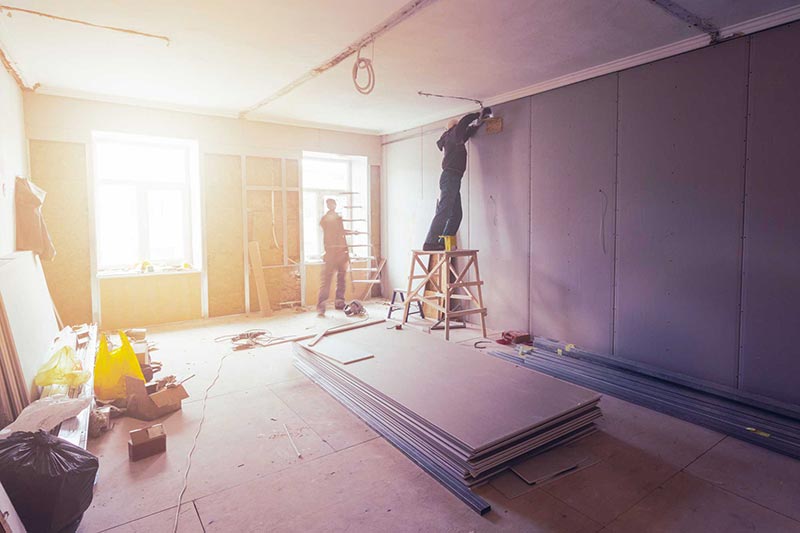
How to Clean a Flooded Basement
When your basement floods, what steps should you take immediately? While it may be tempting to jump right in, many sources of flooding bring contaminated water into your home.
The most important thing is protecting yourself, your family, and your pets. When everyone is safe, property owners should assess the situation with our expert tips, below.
Always Protect Yourself
If you decide to clean the basement yourself, wear an N95 respirator, boots, and protective clothing.
Depending on the source of the water, for example, sewage back up or stormwater, the flood water could be contaminated.
Contaminated water can carry bacteria, viruses, and parasites, such as E.coli and hepatitis. It’s not recommended to clean your own basement if you have a compromised immune system or other health issues. Mold in standing water can also irritate asthma or lung issues.
Before entering your basement, turn off electricity at the breaker and gas at the main valve. Do not stand in water to turn the electricity on or off.
Don’t use an open flame as a light source (there could be a gas leak); instead, use a battery-powered flashlight.
Stop the Source of Flooding
If you can, turn off the water at its source and unblock any available drains.
Special note: don’t attempt to pump water out until the water level inside is greater than the water level outside. Pumping water out earlier may damage the structure due to water pressure.
Have a Professional Check Systems
Depending on the size and severity of the flood, it may be best to let the professionals handle the basement. If your basement has an HVAC system, have a professional who understands mold look at it before turning it on.
And never turn on electrical systems until a professional checks it out. Water is an excellent conductor of electricity!
Call Your Insurance Company
You will most likely need photos to file a claim and you may need additional documentation. Find out what you need for your insurance company, but don’t start to clean until the scene if fully documented.
Ventilate
Open your windows to ventilate the basement. Use fans and dehumidifiers to dry the area.
If your basement has been closed for more than two days, assume there is mold in it. Let the basement air out before cleaning, which, depending on the time of year, can take a few weeks up to a few months.
Use a wet-dry shop vac to vacuum out the area, if a professional has said your electricity is safe to turn on. If using electrical equipment in a wet area, be sure to wear rubber boots.
Remove any mud or debris while it is still moist and allow the area to dry.
Clean or Discard Wet Items
Any porous material – wood, paper, fabric, drywall, carpet, wallpaper, etc. – can grow mold. If it’s been wet for more than 48 hours, you must clean items in a way that will kill mold (such as with a bleach/water solution) or discard them. Glass, plastic, and metal may be able to be cleaned with a strong solution.
Unfortunately, drying out carpet will not kill mold, and you’ll have to replace carpet and carpet pads, drywall, or wallpaper that’s wet. Wood floorboards and furniture can also harbor mold (even dead mold spores can pose health risks).
If you’re not sure what you can safely keep and what must be thrown away or refurbished, content restoration services are available.
How to Clean the Area
When cleaning, wear protective clothing, plastic gloves, goggles, and an N-95 respirator. Make sure the area is well ventilated with open windows, especially when disinfecting with bleach (a basic disinfectant equals one and a half cups of bleach to one gallon of water).
Clean the walls, floors, and ceilings with a towel or rag and the solution, and then throw away towels and cleaning materials in heavy-duty trash bags. Launder your clothes separately from all other clothes or discard them.
It may take several days for the cleaned areas to dry.
When To Call the Professionals…
If you have asthma, an autoimmune disorder, or other health issues that could be worsened by contact with mold, you may want to call a professional.
As a general rule, at Professional Restoration, we recommend calling in the pros if the affected area covers more than nine square feet.
You may also want to call if the job seems overwhelming – it can be a lot of work to properly clean an area to ensure every danger is reconciled—from checking the HVAC system to mold cleaning to electrical concerns.
If you have questions about how to clean a flooded basement or when to call a pro, contact us online or give us a call at 303-922-4001.
For more home safety and cleaning tips, ‘like’ Professional Restoration on Facebook, or follow us on Twitter.

